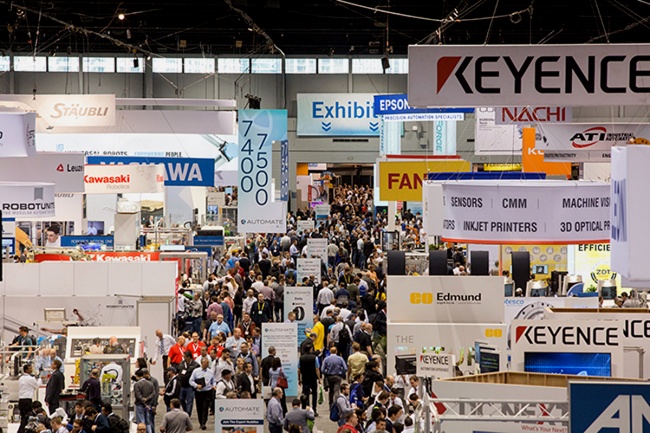Automation Staying Strong

Robotics, machine vision and motion control together with artificial intelligence and digitalization sparking new strategies.
In 1779, so the legend goes, a textile apprentice named Ned Ludd, faced with the task of learning to operate new equipment, got frustrated, rose up and smashed his loom. By 1811, such “Luddites” were known for destroying production machines they thought were used in a “fraudulent and deceitful manner” to replace workers.
Fast-forward 240 years and production automation is thriving. Attendance at AUTOMATE, an every-other-year trade show and conference sponsored by the Association for Advancing Automation (A3), topped 20,000 in early April, a new record and a 25% increase over 2017.
And the Luddite image of robots taking away good jobs is finally being consigned to history where it belongs. Robots were shipped to North American companies in record numbers last year, with more non-automotive companies installing robots than ever before. Statistics from the Robotic Industries Association (RIA), part of A3, show 35,880 units were shipped in 2018, a 7% increase over 2017, with 16,702 shipments to non-automotive companies, up 41%. Food and consumer goods showed notable growth (48%), along with plastics and rubber (37%), life sciences (31%), and electronics (22%).

“While the automotive industry has always led the way in implementing robotics here in North America, we are quite pleased to see other industries continuing to realize the benefits of automation,” said Jeff Burnstein, Association for Advancing Automation president. “And as we’ve heard from our members and at shows such as AUTOMATE, these sales and shipments aren’t just to large, multinational companies anymore. Small and medium-sized companies are increasingly using robots to solve real-world challenges, which is helping them be more competitive on a global scale.”
And the mantra continues to be “automate tasks, not replace workers.” In fact, as employers add automation in its various forms, job titles and tasks are changing, but the number of jobs continues to rise. New technologies allow companies to become more productive and create higher quality products in a safer environment for their employees. For example, Amazon had more than 45,000 employees when it introduced robots in 2014. While the company continues to add robots to its operations and build highly automated distribution centers, it has grown to over 90,000 employees, with a drive to hire more than 100,000 new workers.
Reimagining the Factory Floor
Cobots, or collaborative robots working in close proximity to human workers, continues to grow, but mobile robots are inspiring new visions of production operations, such as no conveyor belts between operations or departments.
At AUTOMATE 2019, Denmark-based Mobile Industrial Robots (MIR) recently launched a new MIR 1000, a mobile robot that can deliver 1000-kg (2200-lb.) payloads throughout a plant. An industry first according to the company is AI-enabled capabilities for improved robot use.
“Intelligent mobile robots make the new industrial layout much more flexible,” says Niels Jul Jacobsen, chief science officer. “Replacing fixed conveyors with easy-to-change layouts mean users can train the system to their needs and changing customer demands.”

Where AI comes in, unlike a traditional AGV, driving behavior and route planning can change via smart cameras that not only recognize obstacles, but together with machine software can predict blocked areas in advance and reroute. In addition, the MIR mobile robots integrate different top modules including pallet lifts, conveyors or cobots for flexible applications where the work can come to the equipment.
Components and Controllers
As many exhibitors were showing, what makes smart devices like robots “smart” are the motors, drives and controllers with AI algorithms built in for data collection and analysis. Mike Chen, director of the Omron’s Automation Center Americas, concurs that interest is building in an AI approach to automation but specifies it has to take place in the real world. “Whether it’s people or the technology making the decisions, it has to be based on real time in the real world, collecting, analyzing and utilizing the data, with all its intellectual, ethical and often safety-related implications.”
Such an approach makes AI an effective bridge between IT (information technology) and OT (operational technology), leveraging the intelligence of human assets (manufacturing engineers, operators, quality and maintenance personnel) with device intelligence. “The entire process becomes more robust the more we decide what to do with both the data and the decisions we can trust technology to make,” he says.
Keeping that data safe from bad actors is also a factor. Omron’s Sysmac AI operates with its own CPU and function blocks, requiring no internet connectivity or cloud computing. Data collection and analysis is performed within the same hardware as the controls program, which also improves data-processing speed and accuracy.For example, devices such as Omron’s Sysmac AI controller are able to identify abnormal machine behavior without being explicitly programmed to do so. Since there could be many different factors and measurements that indicate an issue when observed together, automating the feature-extraction process saves a significant amount of time and resources. Leveraging machine learning results during production is key to ensuring end user-cost savings.
People Remain Central
This is worth pondering. As computing power grows and automation technologies crunch more data and learn more effectively, it will be people – the programmers, the workers and the consumers alike – who will benefit. Rest in peace, Ned Ludd.
Some opinions expressed in this article may be those of a contributing author and not necessarily Gray.
Related News & Insights
Advanced Technology, Automation & Controls
Four Use Cases for AI's Growing Role in Manufacturing
Industry
November 25, 2024Data Centers
Gray Expands Reach with Dallas Office
Corporate News
November 14, 2024Manufacturing, Construction
The Evolving Role of Electric Vehicles in Sustainable Construction & Design
Industry
October 18, 2024